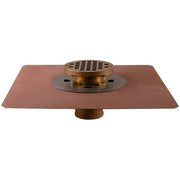Shower Drains
Types of Shower Drains
Modern bathrooms benefit from two distinct shower drain configurations, each offering unique advantages for specific installations.
Linear shower drains provide an elegant, contemporary solution characterized by their elongated design that spans one edge of the shower area. These sophisticated drainage systems create a clean, minimalist aesthetic while facilitating efficient water removal across the entire length of the installation. The extended collection area allows for single-plane floor slopes, simplifying tile installation and creating a more accessible shower environment.
Point drains, alternatively, represent the traditional approach to shower drainage with their compact, centralized design. These shower floor drains require a four-way slope toward the central collection point, creating a classic drainage pattern that works particularly well with smaller format tiles and traditional bathroom designs.
Both configurations can be enhanced with decorative grates that complement surrounding fixtures and finishes, allowing for seamless integration with the overall design aesthetic.
Benefits of Stainless Steel and Copper
The material composition of shower drains significantly impacts both performance and longevity in the demanding bathroom environment.
Stainless steel shower drains provide exceptional corrosion resistance, maintaining their structural integrity and appearance despite constant exposure to water and cleaning agents. Their non-porous surface prevents bacterial growth while resisting staining and discoloration that can affect lesser materials.
Copper alternatives offer similar performance benefits with the added distinction of developing a living finish that evolves over time, creating a unique patina that many designers and homeowners find aesthetically appealing. Both materials demonstrate superior strength compared to plastic alternatives, supporting heavier loads without deflection or damage. Their natural resistance to temperature fluctuations prevents expansion and contraction issues that can compromise drainage connections.
Additionally, these premium materials maintain their appearance for decades, eliminating the need for frequent replacement and providing excellent long-term value despite higher initial investment.
What is the Most Common Shower Pipe Size?
Shower drainage systems typically incorporate standardized piping dimensions to ensure compatibility with existing plumbing infrastructure.
- The most prevalent shower drain pipe size in residential applications is 2 inches in diameter, providing sufficient capacity for standard shower installations while maintaining compatibility with conventional plumbing systems.
- For larger shower installations, particularly those featuring multiple shower heads or high-flow fixtures, 3-inch diameter drains offer enhanced capacity to manage increased water volume efficiently.
- Commercial installations may utilize even larger diameter piping to accommodate higher usage patterns.
Understanding these dimensional standards is essential when selecting replacement drains or planning new installations, as the drain body must properly interface with the existing or planned pipe size. Most premium shower drains incorporate appropriate adapters or are available in multiple connection sizes to ensure compatibility with various plumbing configurations.
Choosing a Shower Drain
Selecting the optimal shower drain requires careful consideration of multiple factors to ensure both performance and aesthetic integration. Begin by determining whether a linear shower drain or point drain better suits your design intentions and existing structural conditions. Consider the installation method – whether the drain will be integrated with a traditional mortar bed installation or a modern waterproofing membrane system. Evaluate water volume requirements based on shower size and fixture flow rates to ensure adequate drainage capacity. Material selection should balance durability, maintenance requirements, and visual integration with surrounding finishes. For renovation projects, carefully assess existing plumbing configurations to determine whether adapter components will be necessary. The drain's grate design should complement the overall aesthetic while providing appropriate slot dimensions to prevent debris accumulation while allowing efficient water passage. Finally, consider long-term maintenance access, ensuring the selected drain provides convenient cleaning capabilities to maintain optimal performance throughout its service life.






























